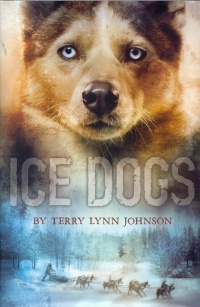| ________________
CM . . . . Volume XXI Number 3 . . . . September 19, 2014
excerpt:
Fourteen-year-old Victoria Secord loves nothing so much as dog-sledding with her lead dog, Bean, through the Alaskan trails. Alone with her dogs, Victoria feels close to her dad whose death one year ago Victoria alternately blames herself and her mother for causing. Since that time, her relationship with her mom has been tense: Victoria is determined not to move to Seattle where her mom grew up, and she's just as determined to win the White Wolf Classic race for her dad. When local racer Jeremy Cook loses his job, Victoria decides to buy a few of his dogs and boost her chances of winning, and she sets off for what should be a four-hour trip to Cook's house. A little cross-country exploration, the discovery of a smashed snowmobile and its injured city boy rider Chris, misdirection, and a snowstorm send Victoria and Chris deep into the Alaskan backcountry. Victoria's outdoor skills are put to the test by dehydration, frostbite, hunger, the cold, and her deepest fear, water, as she and Chris are forced to work as a team to get themselves - and more importantly, the dogs - home alive. Ice Dogs is set toward the end of winter in present day Alaska and is narrated by Victoria in chronological order. Her memories of the past are neatly integrated into the tale without awkwardness or extended flashbacks. Between the immediacy of her needs in the bush and the painful past, Victoria's voice focuses on the present and immediate future, with a believable flavour of teenage attitude toward her mom and small-town attitudes toward Chris, who is not only completely ignorant of how to live in the wilderness, but who has an initially squeamish approach toward hunting and enthusiastic, burly dogs. Victoria's love for her dogs and no-nonsense approach to the work that they require permeate her perspective. Her anger and growing friendship with Chris complement, rather than detract from, the tension of the survival story as Chris learns the basic skills required for life in Spruce River, Alaska, and Victoria learns to work with, and open up to, someone new. Victoria's background relationships with her mom, her dad's twin, Uncle Leonard, and her best friend and complete opposite, Sarah, are painted in minimally, but with enough, depth that they and Victoria's past life feel convincingly substantial. Readers will be introduced to a new vocabulary which includes sledding terms, such as runners, stanchions, and lead dog, and clothing such as mukluks and polypro undershirts. Some of these terms are self-explanatory, some are defined when they are first used, while others are not. This should not prove difficult for readers, however; complete comprehension of a sled's mechanical workings, for example, is not necessary to get a sense of the work and tactics involved in slowing it down. The beauty and severity of the far north and the mix of isolation and community of the people who inhabit this region are movingly portrayed in a manner alternately matter of fact and poetic as Victoria and Chris struggle with their circumstances and the results of their own choices. Highly Recommended. Janet Eastwood is a student in the Master of Children's Literature program at the University of British Columbia. Copyright © the Manitoba Library Association. Reproduction for personal use is permitted only if this copyright notice is maintained. Any other reproduction is prohibited without permission.
Next Review |
Table of Contents for This Issue
- September 19, 2014. |
